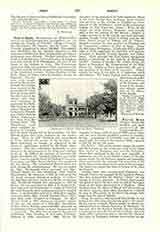

Port of Spain, Archdiocese of (PORTUS HISPANIAE), an archiepiscopal and metropolitan see, including the Islands of Trinidad, Tobago, Grenada, the Grenadines, St. Vincent, and St. Lucia. The Catholic population is about 200,000. Christianity was introduced by the Spanish discoverers, and missions established in those islands where permanent settlements were effected. The first preachers of the Faith in Trinidad were Fathers Francisco de Cordova and Juan Garces, both Dominicans, who died at the hands of the Indians in 1513. The Franciscans arrived in 1596, and maintained their connection with Trinidad until the British occupation in the beginning of the nineteenth century. Fathers Esteban de San Felix, Marco de Vique, and a lay-brother, Ramon de Figuerola, Franciscans, were slaughtered by the natives in 1699. Their bodies were interred in the parish church of San Jose de Oruna, then the chief town of the colony, and they were venerated as martyrs of the Faith. The Governor of the colony, Don Jose de Leon, and a Dominican, Father Juan de Mosin Sotomayor, lost their lives defending them. The Dominicans and other religious labored in Grenada and the other islands, but as these colonies fell into British hands they were replaced by the secular clergy. When in 1797 Trinidad was surrendered to Great Britain the status of the Catholic religion underwent no change, as stipulated in the terms of capitulation granted by Sir Ralph Abercrombie. The new authorities undertook to contribute to the maintenance of the clergy and continue to do so. In 1820 at the instance of Governor Sir Ralph Woodford, the Trinidad Catholics were with-drawn from the jurisdiction of the Bishop of Guayana, Venezuela, and Msgr. James Buckley was appointed the first bishop. The cathedral of Port of Spain was built during his administration. He was succeeded by Msgr. McDonnell, whose successor was Msgr. Richard Smith, the first archbishop. Msgr. Vincent Spaccapietra, his successor, is held in veneration for his heroic exertions during an epidemic of cholera. On Msgr. Spaccapietra’s transfer to the See of Smyrna, Msgr. Ferdinand English was appointed to Port of Spain. He was succeeded by Msgr. J. L. Gonin, O.P., who requested the Dominicans to resume in Trinidad the work begun by their predecessors in early Spanish days. A small number arrived in 1864; their number increased under Msgr. Patrick Vincent Flood, O.P., and their work extended to Grenada. On Msgr. Flood’s death in 1907 during an extended vacancy of the see, the name of a Canadian Dominican, Father Albert Knapp, unaccountably appeared as Archbishop of Port of Spain in many newspapers and a year book. The Holy See appointed the present archbishop, Msgr. Dowling, b. in County Kilkenny, Ireland, in 1886, consecrated 1909. Before his elevation to the episcopate he held important offices in his order, having been professor, novice-master, and previous to his coming to Trinidad as vicar-general of the archdiocese, rector of the well-known College of San Clemente, Rome. Most of the clergy are from France, England, and Ireland, only a few are natives of the diocese. English is taught exclusively in the schools and most generally spoken, though Creole patois is widely used by the lower classes except in Tobago and St. Vincent. Spanish is spoken in some parishes of Trinidad and by Venezuelan residents of Port of Spain. There are also many Portuguese. Confessors with a knowledge of these languages are provided and sermons preached in English, French, Spanish, and Portuguese. Work amongst the East Indian immigrants makes a knowledge of the dialects of Hindustan needful. Number of parishes, 48; secular clergy, 20; Order of Preachers, 40; Congregation of the Holy Ghost, 15; Fathers of Mary Immaculate, 20; and a few members of the Order of St. Augustine. Higher schools for boys, 2, for girls, 4; 1 orphanage and 2 alms-houses. The Leper Asylum and the municipal alms-house are under the care of the Sisters of St. Dominic, and many of the elementary schools under that of the Sisters of St. Joseph.
MICHAEL O’BYRNE

